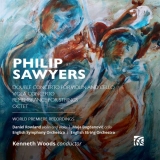Im Jahre 2009 wurde der 1951 geborene Philip Sawyers vom Sydenham Festival beauftragt, ein Cellokonzert für Maja Bogdanovic zu schreiben. Doch dann wurde daraus ein Doppelkonzert für sie und ihren Ehemann, den Geiger Daniel Rowland. Es beginnt mit einem farbigen und reich nuancierten Allegro moderato, organisch entwickelt auf langen Melodiesträngen. Das folgende Andante ist wunderbar melodisch, das Finale kontrastreich und, wenn auch mehrmals nachdenklich abgebremst, so doch eigentlich sehr beschwingt und im Grunde heiter.
Dann folgt das besinnlich-elegische Streicherwerk Remembrance, ehe das Programm mit dem Bratschenkonzert aus dem Jahr 2020 fortgesetzt wird. Es beginnt mit einem an Motiven reichen Allegro, das aber wegen seiner leichten Orchestrierung den Klang der Bratsche sonor in den Mittelpunkt stellt. Im zentralen Andante führt die Viola eine Art Selbstgespräch, meist nur umrahmt von einigen Bläsern. Das abschließende Allegro enthält zwar auch virtuose Passagen, bleibt aber auch nicht selten sehr nachdenklich. Und am Ende hat man den Eindruck, ein formal wie ausdrucksmäßig starkes Werk gehört zu haben, das wie die übrigen Orchesterwerke in einer exzellenten Darbietung zu hören ist.
Das Oktett für Klarinette, Horn, Fagott, 2 Geigen, Bratsche, Cello und Kontrabass aus dem Jahr 2007 besteht aus einem durchgehenden Satz in vier Abschnitten: einem sehr stimmungsvollen, fast zärtlichen
Adagio, einem beschwipsten Allegro, einem verträumt lyrischen Andante und einem weiteren, sehr alerten Allegro.
Und somit kann man dem Herausgeber Nimbus nur gratulieren, diese interessante CD auf den Markt gebracht zu haben.
In 2009, Philip Sawyers, born in 1951, was commissioned by the Sydenham Festival to write a cello concerto for Maja Bogdanovic. But it then became a double concerto for her and her husband, violinist Daniel Rowland. It opens with a colorful and richly nuanced Allegro moderato, organically developed on long melodic strands. The Andante that follows is wonderfully melodic, the finale contrasting and, though thoughtfully slowed several times, actually very upbeat and essentially serene.
Then follows the contemplative, elegiac string work Remembrance, before the program continues with the Viola Concerto from 2020. It begins with an Allegro rich in motifs, but its light orchestration allows the viola’s sound to take center stage sonorously. In the central Andante, the viola engages in a kind of soliloquy, mostly framed only by some winds. The concluding Allegro also contains virtuosic passages, but also often remains very pensive. And at the end, one has the impression of having heard a formally as well as expressively strong work, which, like the other orchestral works, can be heard in an excellent performance.
The Octet for clarinet, horn, bassoon, 2 violins, viola, cello and double bass from 2007 consists of a continuous movement in four sections: a very atmospheric, almost tender
Adagio, a tipsy Allegro, a dreamily lyrical Andante and another very alert Allegro.
And so one can only congratulate the publisher Nimbus for releasing this interesting CD.






















